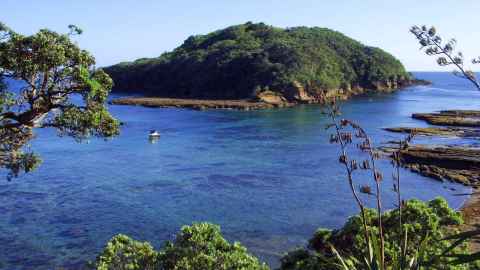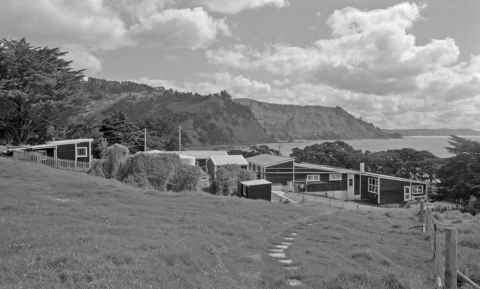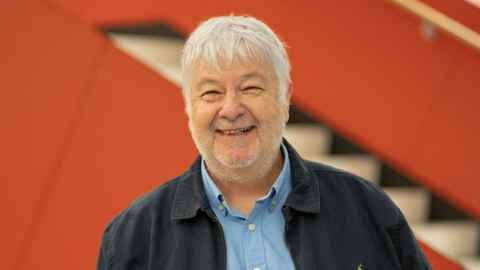‘A living lab’ - NZ’s first marine reserve turns 50
20 October 2025
Half a century has passed since marine scientists won the battle to establish a marine reserve around Te Hāwere-a-Maki/Goat Island, north of Auckland.

Cape Rodney-Okakari Point Marine Reserve became New Zealand’s first no-take marine reserve in 1975 and will celebrate its 50th anniversary on 26 October.
University of Auckland marine scientists Professor Simon Thrush and Professor Conrad Pilditch say massive transformations have occurred within the marine reserve over the past five decades.
When the area was first protected, the rocky reefs were bare and looked white in aerial photographs.
It took almost 30 years for kelp forests to return, providing a nursery for juvenile fish and habitat that saw many species return, says Thrush.


These days, the reserve features a far higher density of fish and diversity of other marine life than is found outside its boundaries.
It’s home to parrotfish, black angelfish, blue maomao, red moki, silver drummers, leatherjackets, octopus, and several species of stingrays, while bottlenose dolphins and orcas occasionally pass through.
“As the first legislated marine reserve in New Zealand, it has provided a place of contrast that has allowed us to demonstrate and understand the level of impact of commercial and recreational fishing.
“We’ve been able to study the recovery of this place, which is a refuge from some forms of human disturbance, mainly fishing,” says Thrush.


In 1964, the University of Auckland’s Leigh Marine Laboratory opened on the cliffs above the area where the marine reserve was later established.
The lab’s first director, marine biologist Dr Bill Ballantine, was a key force pushing for the marine reserve to be set up.
All those years ago, Ballantine was concerned that fish stocks were dwindling and marine ecosystems were declining in the Hauraki Gulf – though it was in a far better state then, than it is now, says Pilditch.
Since 1975, Auckland’s population has exploded and recreational and commercial fishing pressures have increased markedly, he says.
These days, visitors to Te Hāwere-a-Maki/Goat Island might experience the marine reserve as like an oasis, teeming with fish.

However, Pilditch says fish are not as plentiful within the reserve now as they were in the late 1970s.
Certainly, fish stocks in the reserve remain far below the levels that would have been present before commercial fishing began in the area, he says.
“Commercial and recreational fishing has increased in the Hauraki Gulf and the marine reserve has been impacted by that over the last few decades, basically because it’s too small.
“Large snapper and crayfish sometimes move out of the reserve and get caught, and the outside areas aren’t helping replenish the reserve, because they’re heavily fished,” says Pilditch.

Crayfish numbers and sizes began to recover when the marine reserve was established, but have dropped again over the past 10 years.
Fishing has intensified along the reserve boundaries and numbers of crayfish have dropped in the region, he says.
Working at Leigh, University of Auckland Associate Professor Nick Shears provided key evidence that crayfish and large snapper play an essential role in keeping marine reef ecosystems healthy.
“These predators eat kina, which otherwise increase in numbers and mow down kelp forests,” says Thrush.
At Te Hāwere-a-Maki/Goat Island it took about 30 years for snapper and crayfish to mature and play their part in lowering kina numbers, allowing kelp forests to regenerate naturally.

Recent research shows in some places people can speed up kelp restoration by removing kina, but large snapper and crayfish are still needed to maintain the balance long-term, says Thrush.
“On land in New Zealand we want to be predator free, but for our seas, we need our predators back,” he says.
Another key discovery has been that the reserve's many mature snapper produce about 10 times more juvenile snapper than are produced from unprotected areas of the same size.
About 11 percent of young snapper found up to 40 kilometres away from the reserve were offspring of snapper that live in the reserve.
“People think you’re locking up areas, but the spillover effect means the reserve is actually enhancing fisheries in the Hauraki Gulf,” says Pilditch.
The legislation that launched Goat Island marine reserve – the Marine Reserves Act 1971 - has led to another 43 no-take marine reserves being created in New Zealand.
The recently passed Hauraki Gulf Marine Park Bill will make the 556ha Goat Island marine reserve about four times larger, extending the offshore boundary from 800m to 3km.
Thrush and Pilditch say the marine reserve has demonstrated the value of safeguarding patches of sea, but it has also shown that reserves need to be larger to better protect key species, such as crayfish and snapper, from fishing pressures.
“It’s also important to protect different types of habitat,” says Thrush.

Having a “living lab” observing what happens over 50 years has provided unique insights of international importance, Pilditch says.
“As the impacts of climate change worsen, those historical records and that understanding will be incredibly important, to have a baseline to compare with,” he says.
Restoring kelp and fish abundance in the reserve has made the area more resilient to climate change, while also contributing to carbon sequestration, says Pilditch.
If kelp forests in the Hauraki Gulf were restored, they would be worth about $7.9 million in carbon credits, if they were valued in the same way as land-based forests, says Thrush.
About 350,000 people visit the reserve annually, mostly to snorkel, dive or take a glass-bottom boat trip to explore the abundance of life beneath the waves.
Younger generations gain knowledge of the underwater world at the University’s Goat Island Marine Discovery Centre, which is open to the public and offers educational activities to thousands of students each year.
Pilditch and Thrush say it’s wonderful to see so many people connecting with the world beneath the waves, but they also look forward to seeing new marine protected areas being created when the Hauraki Gulf Marine Protection Bill comes into effect later this year.
“It’s fabulous so many people make the journey there, but we wouldn’t have these numbers of people if the rest of the gulf wasn’t in such a perilous state.
“A lot more places could look like the marine reserve if we managed our oceans better,” says Pilditch.
Media contact
Rose Davis | Research communications adviser
M: 027 568 2715
E: rose.davis@auckland.ac.nz